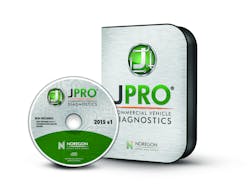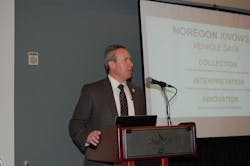NASHVILLE. Noregon Systems released an update for its JPRO commercial vehicle diagnostics program at the 2015 Technology & Maintenance Council (TMC) annual meeting that expands model year coverage for a variety of heavy, medium, and light-duty vehicles as well as for two diesel engine families.
Greg Reimmuth, Noregon’s senior VP-sales and marketing, said the new JPRO Commercial Vehicle Diagnostics 2015 v1 includes expanded coverage of model years and diagnostic data for:
- Freightliner and Freightliner Cascadia body and chassis controllers;
- Detroit and Cummins engines;
- Ford, GM and Sprinter vehicles;
- And a new “demo mode” to enable users to explore JPRO features quickly and easily without the need to access a vehicle.
“Our research shows that 85% of truck repairs don’t require OEM software to fix them,” Reimmuth (at right) explained. “JPRO allows technicians to identify and separate those repairs from ones needing OEM software. Like triage in a hospital emergency room, it tells you what repair requires only a nurse for a few stitches and what needs the heart surgeon or in the truck repair world an A-level technician.”
He added that Noregon is also looking to tap into the “reservoir” of truck repair data it’s gathered over the last decade to create what the company calls a “Truck Checkup Kiosk” service that with allow drivers to literally “self-diagnose” trucks while refueling for a fee.
“The average heavy-duty truck produces 3.5 to 4 fault codes per operating day and therein lies the inherent problem: a lot of data but little information as to what codes indicate critical issues,” he said. “Based on our data reservoir, we’re creating a simple truck ‘health report’ that can quickly determine for a driver whether their truck is healthy or not while at a fuel stop.”
While this service isn’t commercialized as of yet, Reimmuth noted that Noregon hopes to have it ready to go live by March.
About the Author
Sean Kilcarr
Editor in Chief
Sean Kilcarr is a former longtime FleetOwner senior editor who wrote for the publication from 2000 to 2018. He served as editor-in-chief from 2017 to 2018.

